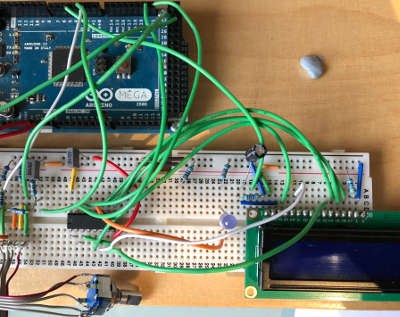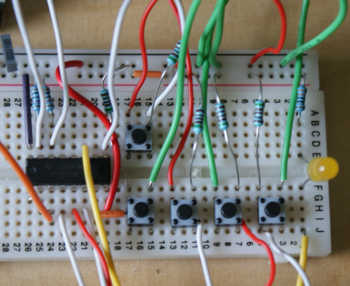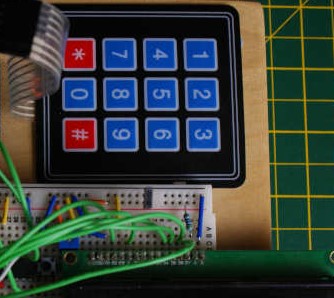TcMenu Designer UI - worked example
Worked example: Building a timer For this example we will create a menu that has two top level menu items; a counter which counts down from the selected value, and a Boolean switch that turns on or off the countdown. It will also have a submenu with one menu item to control the notification method. So lets draw this out conceptually below menu root +- countdown, integer values 0 to 1000 seconds +- enabled, boolean YES, NO.
AW9523 I2C IoExpander with LED controller - Arduino and mbed
IO Abstraction library fully supports the AW9523 16-bit IO expander chips on Arduino and mbed. It requires only two pins (three for interrupt mode) SDA, SCL, and optionally INT. Our driver integrates the GPIO, LED controller, and interrupt support providing nearly all functions using familiar Arduino terminology. This device can even be used in conjunction with an AW9523 analog device to make it even easier to use the LED controller.
MCP23017 I2C IoExpander for Arduino and mbed
IO Abstraction library fully supports the MCP23017 16-bit IO expander chips on Arduino and mbed. It requires only two pins (three for interrupt mode) SDA, SCL, and optionally INT. Our driver provides nearly all functionality using similar terminology to Arduino itself. The MCP23017 provides 16 additional input or output ports, they have very similar capabilities to device pins and interrupt support is managed per pin. This device can be used for switches, rotary encoders, and with LiquidCrystalIO.
MPR121 I2C Touch/IoExpander/LED controller - Arduino and mbed
IO Abstraction library fully supports the MPR121 12-bit Touch control and IO expander chips on Arduino and mbed. It requires only two pins (three for interrupt mode) SDA, SCL, and optionally INT. Our driver integrates the Touch, GPIO, LED controller, and interrupt support providing nearly all functions using familiar Arduino terminology. This device can even be used in conjunction with an MPR121 analog device to make it even easier to use the LED controller.
PCF8574 / PCF8575 I2C IoExpander for Arduino and mbed
IO Abstraction library fully supports the PCF8574 8-bit and PCF8575 16-bit IO expander chips on Arduino and mbed. It requires only two pins (three for interrupt mode) SDA, SCL, and optionally INT. Our driver integrates the interrupt support for you so you can attach interrupts very easily. The PCF8574 provides 8 additional input or output ports, but there are few limitations around how the device can be used, and these are discussed below.
LiquidCystalIO with MCP32017 I2C or any other arrangement
You can connect up a device using just about any arrangement of pins or expander, at the end of the day any device supported by IoAbstraction, including MultiIo (pins and IoExpander mix) can be used here. Examples showing these use cases MCP23017 LiquidCrystal example Shift register 74HC595 LiquidCrystal Back to the main page
IoAbstraction: Using a matrix keyboard / keypad
Matrix keyboards are arranged such that the keys are in a matrix of rows and columns. This means that instead of needing a spare input for each key, one INPUT for each column and one OUTPUT for each row is all that’s needed. In order to use the keyboard, we create a class of type MatrixKeyboardManager and configure it with an IoAbstractionRef, a KeyboardLayout that describes the keyboard attached (there are some standard ones already defined) and a listener that will be informed of changes.
Arduino Button presses that are handled like events
Have you ever wanted to treat button presses in Arduino similar to other languages, where you get an event callback when the switch is pressed? Look no further, the IO abstraction library can do that with very little fuss. In fact it can also do the same for rotary encoders as well, treating them similar to how scroll bars work in desktop applications. To start we need to get the IoAbstraction library and open the buttonRotartyEncoder example.
Programming Arduino using tasks instead of loops - tutorial
In this tutorial for TaskManagerIO I explain the differences between traditional loop based programming; which is very common on the Arduino platform and event based programming based on taskManager. Although event based programming looks slightly more complicated at first, as the sketch and surrounding code gets more complex, eventing will scale to that much easier. Eventing task frameworks make ongoing maintenance much easier. Example: Two LEDs blink at different rates. Let’s first take a look the traditional loop based approach, we’ll start by setting things up:
Liquid Crystal fork example using IO Abstraction library - examples
Recently, I have made a fork of Arduino LiquidCrystal (HD44780 display driver library) that allows the library to work with the IO abstraction library, meaning you can configure a display to use Arduino pins, an i2c 8574 IO expander or shift registers by simply changing one line of code in your sketch. There are two additional examples provided with this version that show how to use the fork with both a shift register and an 8574 i2c IO expander.








